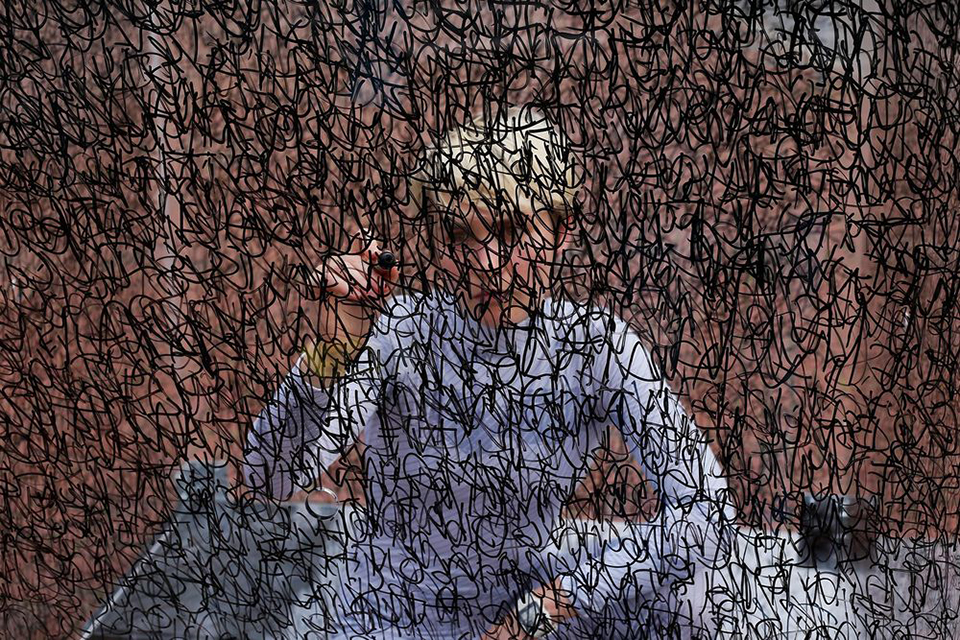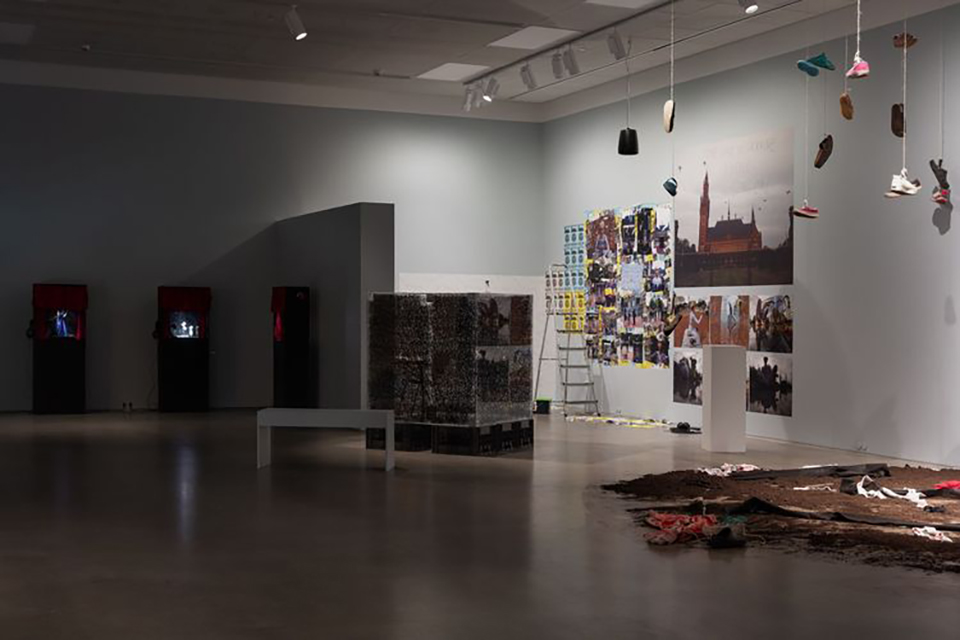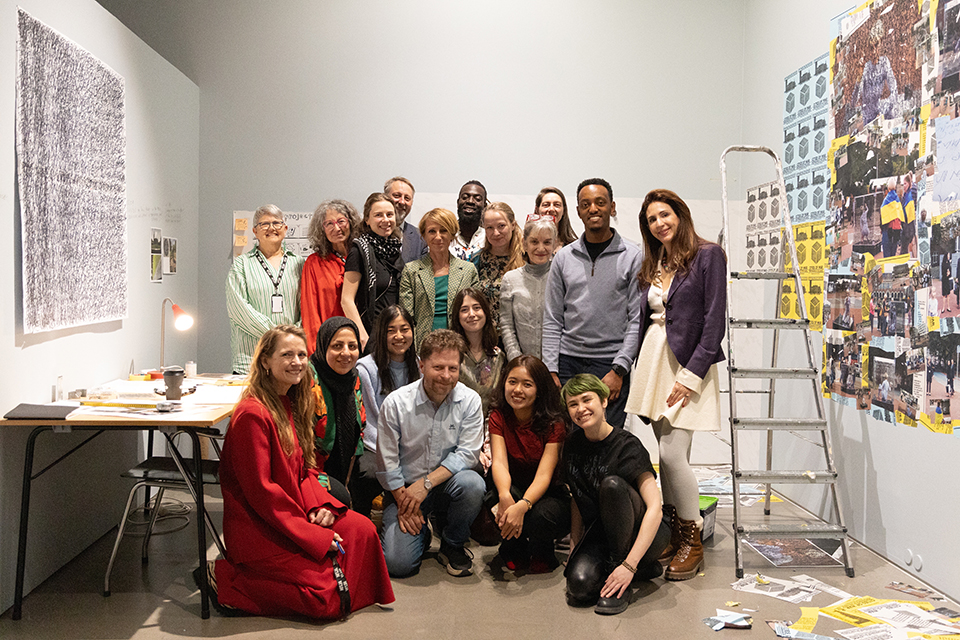INSPIRE Art Award – collaborations with artists from across political spaces of marginalisation and war-zones
By Katarzyna Grabska, PhD, Research Professor, Peace Research Institute Oslo (PRIO)
Walking through the exhibition hall of Nitja Centre for Contemporary Art in Lillestrom, outside of Oslo, I was wondering about the powerful ways in which art can address the most difficult human experiences of political violence, war, displacement, memory, belonging and home. Key questions popped out: What inspires and motivates artists coming from such contexts to engage in creative practice? How do artistic expressions inspire and move others to action for social justice during and after war? How do artists, art and activism intersect in and after wars in countries engaged in armed conflicts, and amongst exiled artists around the world?
 Daria Pugachova, "Cities of War", performance, 5 hours, International Court of Justice, The Hague, 2023. Photo: Hosein Danesh
Daria Pugachova, "Cities of War", performance, 5 hours, International Court of Justice, The Hague, 2023. Photo: Hosein Danesh
On Saturday 20th April 2024, the Inspire Art Award exhibition at the Nitja Centre for Contemporary Art opened to the public. It was an unusual exhibition based on the first edition of the INSPIRE Art Award initiated by the Peace Research Institute Oslo in Norway (PRIO) and co-founded by Anais Lellouche (independent curator, the UK) and myself Katarzyna Grabska (PRIO). The INSPIRE Art Award is an initiative of Inspirational Creative Practice: The Work of Artists after War and Violent Conflict (INSPIRE). INSPIRE is a research project that studies the role of artists and creative practice in and after violent conflict. The project (2020-2025) is hosted by PRIO. The Inspire Art Award was conceived as interdisciplinary, and the nominated artists work with various media and expressions including video, social projects, performance, photography, installation, and contemporary dance.
 INSPIRE Art Award Exhibition, Nitja. Photo: @ Sakib Saboor, April 20, 2024
INSPIRE Art Award Exhibition, Nitja. Photo: @ Sakib Saboor, April 20, 2024
The five artists in the exhibition had been selected following an international open call in 2022, in which artists with experiences from war, displacement and political violence could apply. The jury members were Toni Shapiro-Phim (dance anthropologist, professor, USA); Marine Van Schoonbeek (director of Thanks for Nothing, France); Othman Lazraq (director Foundation Alliances, Morocco), Huda Lutfi (artist, art historian, Egypt), Akram Khan (dancer and choreographer, the UK), Nathalie Anglés (director of Residency Unlimited, USA), Anaïs Lellouche (curator and art advisor, the UK), Katarzyna Grabska (anthropologist, research professor PRIO, Norway), Monica Holmen (curator, Nitja, Norway).
 Zun May Oo, «The Shadow of Heroes» (2023). Photo: Eyoeal Kefyalew
Zun May Oo, «The Shadow of Heroes» (2023). Photo: Eyoeal Kefyalew
From over 100 applications coming from 35 countries across the globe, the international jury nominated:
Zahrasadet Hakim, visual artist from Iran/Iraq (based in Switzerland)
Daria Pugachova, performance artist from Ukraine (based in Ukraine)
Gervais Tomadiatunga, dancer from DRC (based in France)
Zun May Oo, visual artist from Myanmar (based in Thailand)
Eyoeal Kefyalew, photographer from Ethiopia (based in Ethiopia)
The exhibition presented artistic reflections on violent experiences from war and displacement that were transformed into vibrating and vulnerable expressions.
Representing different artistic practices and disciplines, different geographies, and different contexts, they all bring attention to past and ongoing, visible and forgotten conflicts in the world. Puppet theatre stemming from the traditional art in Myanmar and reflecting on the ongoing coup d’état, piles of soil and flip flops referring to the experiences of child soldiers in past and ongoing conflicts in the Congo, a black box – a suitcase of pictures filled with memories of the Eritrean-Ethiopian war of independence in the 1990s, wooden sculptures and leftovers from a meal served on a mirror narrating experiences of war, displacement, migration and belonging between Iraq, Iran, Syria and Switzerland. The objects in this exhibition all carried memories of violence and war within them, but they also brought hope and light into our understanding of these traumatic and violent experiences.
 Gervais Tomodiatunga in performance. Photo: @ Sakib Saboor, April 20, 2024
Gervais Tomodiatunga in performance. Photo: @ Sakib Saboor, April 20, 2024
While these works were diverse and powerful in their own right, they were united by the common thread running through them - the personal stories that they share. As feminists have long noted, the personal is political. The works that we had a chance to see at the exhibition had a strong sense of storytelling as a base of creative expression, being it through the puppet installation (Zun May Oo), to street performance and project documentation (Daria Pugachova), dance performance and installation (Gervais Tomadiatunga), photo installation (Eyoeal Kefyalew), or video and performance installation (Zahrasadat Hakim). While sharing personal stories, all artists speak to universal concerns about the world filled with uncertainties affecting us all.
 Installation, Eyoeal Kefyalew. Photo: @ Sakib Saboor, April 20, 2024
Installation, Eyoeal Kefyalew. Photo: @ Sakib Saboor, April 20, 2024
Walking through the exhibition hall, one has a strong sense of resilience and hope present in each of the creations. But there is something even deeper, stronger that emerges through these works. The artists and their works remind us about the possibility for change. And change in today’s geopolitical circumstances is perhaps more important than inspiration alone. As Akram Khan, a jury member, eloquently expressed during the final deliberations:
People change when they hurt enough that they have to.
People change when they see enough that they are inspired to.
People change when they learn enough that they want to.
People change when they receive enough that they are able to.
One leaves the exhibition with a sense of urgency. The strong sense of the political in each of the personal stories narrated through different artistic expressions speaks to issues of violent conflicts, displacement, dispossession, loss and the need for justice and recognition. Historically, artists have always maneuvered complicated political, authoritarian and conflict contexts in order to process and transform experiences, to protest, to speak out, but also to create alternatives to the mainstream narratives about the political contexts in which they worked and lived. Nowadays, art seems even more important as a way to offer thought-provoking and subtle ways of encouraging us to reimagine the world in radical, new ways.
 INSPIRE Art Award team. Photo: @ Skib Saboor, April 20, 2024
INSPIRE Art Award team. Photo: @ Skib Saboor, April 20, 2024
On the occasion of the opening, the first ever recipient of the Inspire Art Award was also announced. After thorough deliberations, the jury decided to award the Inspire Art Award to Zahrasadat Hakim. The laureate artist receives a residency at Residency Unlimited, New York. Read the jury statement.
Zahrasadat Hakim (b. 1983, Iran) was born in Iran as an Iraqi migrant and later moved to Switzerland as an Iranian. The first five years of her life coincided with the war between Iraq and Iran. Hakim’s personal experience and relationship with the memory of war, as well as several intended and unintended displacements, inspire her work. Zahrasadat Hakim has an MA in Visual Art from HEAD GENEVE (2020–2022), and BA in Visual Art from Geneva University of Art and Design (2017–2020). Hakim studied painting at Tehran University (2005–2006).
 Zahrasadat Hakim, "Two Lakes Behind Memories" (2024).
Zahrasadat Hakim, "Two Lakes Behind Memories" (2024).
Photo: Kunstdok / Tor Simen Ulstein
The INSPIRE Art Award is very grateful to partner with Nitja Centre for Contemporary Art, Goethe Institut, the Peacebuilding and the Arts Program (Brandeis University), Residency Unlimited and Thanks for Nothing.